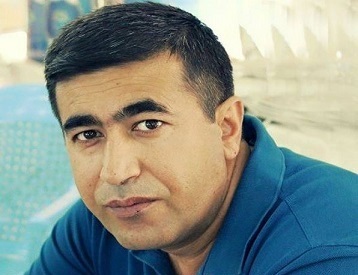
Страна: Азербайджан
Гараев Садыг Гурбан оглы. Доктор философских наук, доцент, член Союза писателей Азербайджана и России. Научной работой занимаюсь с 1997 года, литературой с 2014 года. Я автор 45 научных статей, теории «Орбиты и универсального существования», романов «Контрасты без берега» и «Тени без хозяев», рассказов и повестей. Я люблю путешествовать, наблюдать за растениями, играть в шахматы и заниматься спортом. Я люблю пасти ягнят.
Country: Azerbaijan
Garayev Sadig Gurban oglu. Doctor of Philosophy, Associate Professor, member of the Writers’ Union of Azerbaijan and Russia. I have been doing scientific work since 1997, literature since 2014. I am the author of 45 scientific articles, the theory of «Orbit and Universal Existence», novels Contrasts without a shore and «Shadows without Masters», stories and novellas. I love to travel, observe plants, play chess and play sports. I love to graze lambs.
Рецензия на книгу Надежды Серебренниковой “Дневник Ёжика-путешественника или Где живёт счастье?”
In the book by Nadezhda Serebrennikova «The Hedgehog Traveler’s Diary or Where Does Happiness Live?» there are many interesting episodes. These episodes allow children to build their own worlds and dreams, while at the same time there are useful ideas for getting to know the world and nature.
The hedgehog kid wants to keep a diary and doesn’t know where to start. In this diary, he simply calls himself a «hedgehog.» After all, his mother also calls him and his brothers by the same name, «hedgehog.» He simply distinguishes brothers by tone of voice.
In the Yezhov school, hedgehogs are taught to read and write. He cannot find a friend and, perhaps, therefore, decides to keep a diary. He loves looking at the sky and clouds and compares the shape-shifting clouds to a water horse in a pink hat. When the hedgehog looks at the water horse, he finds a sea urchin and wants to talk to him. He wants to tell him about the land. And the sea urchin talked about aquatic life. And so, the hedgehog goes to see the sea urchin, make friends and find out where happiness lives.
Here the author expresses the children’s desire to travel to interesting worlds and the desire to learn. Here the author expresses the desire of children to always travel to interesting worlds and shows what they want to learn. He describes the world of children, in particular, as always in search of their own happiness. He especially describes that children who are looking for their happiness in the world are always in search.
A hedgehog meets a beaver on the way. Beaver told him that people destroyed their houses and wants revenge. The hedgehog refuses to take revenge. The author describes how people harm nature and animals.
The hedgehog climbs into the girl’s car and hides. But when the hedgehog sneezes, the girl sees him, she likes him and takes him home. The hedgehog is bored here. When he was shown to guests, he felt ashamed. Also becomes lazy and fat. The author wants to say that children who do not play and are less active become lazy and gain weight. A hedgehog, who is about to run away from home, climbs into the suitcase of a traveling neighbor. The airport employee looks at the monitor and is very surprised. He first saw a flying hedgehog.
The hedgehog, finding an opportunity to escape from the suitcase, gets to the forest. Here he meets a frog. The frog sees him sneeze and advises him to stay away from the flowers. The author wants to tell the children that they should not touch flowers and plants while traveling. The hedgehog tells the frog that he wants to see the sea urchin. The frog takes him to the edge of the abyss. There was the sea below. The hedgehog lands on the shore with the help of a seagull. Here he speaks to crayfish. When asked where happiness is, a cancer child answers «at the bottom of the sea.» This shows that everyone has happiness in different places.
Cancers see seagulls, run away in fear and hide. Then they talk about how difficult and dangerous their life is. Thus, the author declares that life is difficult for all living things and that everyone has enemies. At the same time, it shows that people pose a threat to all living things in nature.
Finally, a hedgehog meets a sea urchin. He asks how they live at sea. The sea urchin talks about what is happening in the sea, and the hedgehog talks about the forest in which it lives.
The hedgehog asks the sea urchin where happiness is. The sea urchin Sim replies that no one knows this. Maybe except for the sky. Thus, the author claims that God knows where real happiness is. Shem says that when he was young, he also received many letters from heaven. But he was indifferent to them. Thus, the author advises people of different ages to try for their own happiness.
The hedgehog leaves the shore and makes friends with Serboa on the way. Wild watermelons save them from thirst. Serboa and hedgehog look at fish with human eyes.
At the end, the hedgehog returns to his home in the forest. Brings his friend Serboa with him. On the way, Serboa sees that he is very happy. Indeed, the hedgehog was very happy to be reunited in the forest with his brother and sister, as well as his father and mother.
The main conclusion of Nadezhda Serebrennikova from this work is that real happiness is at home and with family. Those who travel the world in search of happiness actually love travel and adventure. Finally, tired of this, they return to their homeland, to their relatives.
The work is of great educational value and also very interesting. Congratulations to the author.
В книжке Надежды Серебренниковой «Дневник Ёжика-путешественника или Где живёт счастье?» есть много интересных эпизодов.
Эти эпизоды позволяют детям строить свои собственные миры и мечты, в то же время есть полезные идеи для знакомства с окружающим миром и природой.
Малыш-ежик хочет вести дневник и не знает, с чего начать. В этом дневнике он называет себя просто «ёжиком». Ведь мать тоже называет его и его братьев одним именем, «ёжик». Он просто отличает братьев по тону голоса.
В Ежовской школе ёжиков учат читать и писать. Он не может найти друга и возможно, поэтому решает вести дневник. Ему нравится смотреть на небо и облака, он сравнивает меняющие форму облака с водяным конем в розовой шапке. Когда еж смотрит на водяного коня, он находит морского ежа и хочет с ним поговорить. Он хочет рассказать ему о земле. А морской еж рассказал о водной жизни. И так, ёжик едет увидеть морского ежа, подружиться и узнать, где живет счастье.
Здесь автор проявляет желание детей путешествовать по интересным мирам и желание учиться. Здесь автор выражает желание детей всегда путешествовать по интересным мирам и показывает то, чему они хотят научиться. Он описывает мир детей, в частности, как всегда находящихся в поисках собственного счастья. Особенно описывает, что дети ищущих в мире своего счастья, всегда в поисках.
Ежик встречает по дороге бобра. Бобр рассказал ему, что люди разрушили их дома и хочет отомстить. Ёжик отказывается мстить. Автор описывает, как люди вредят природе и животным.
Ежик забирается в машину девушки и прячется. Но когда ёжик чихает, девушка видит его, он ей нравится и забирает домой. Ёжик здесь скучает. Когда его показывали гостям, ему становился стыдно. Также становится ленивым и толстым. Автор хочет сказать, что дети, которые не играют и менее активны, становятся ленивыми и набирают вес. Ежик, который собирается сбежать из дома, залезает в чемодан путешествующего соседа.
Сотрудник аэропорта смотрит на монитор и очень удивляется. Он впервые увидел летающего ежа.
Ежик, найдя возможность вырваться из чемодана, добирается до леса. Здесь встречается с лягушкой. Лягушка видит, как он чихает и советует держаться подальше от цветов. Автор хочет сказать детям, что во время путешествия нельзя трогать цветы и растения. Ёжик говорит лягушке, что хочет увидеть морского ежа. Лягушка подводит его к краю пропасти. Внизу было море. Ежик приземляется к берегу с помощью чайки. Здесь он говорит с раками. На вопрос о том, где счастье, ребенок-рак отвечает «на дне моря». Это показывает, что счастье у всех в разных местах.
Раки видят чаек, в страхе убегают и прячутся. Затем они говорят о том, насколько трудна и опасна их жизнь. Таким образом автор заявляет, что жизнь трудна для всего живого и что у всех есть враги. В то же время это показывает, что люди представляют угрозу для всего живого в природе.
Наконец-то ежик встречает морского ежа. Он спрашивает как они живут на море. Морской еж рассказывает о том, что происходит в море, а ежик говорит про лес, в котором живёт.
Ёжик спрашивает морского ежа, где находится счастье. Морской еж Сим отвечает, что никто этого не знает.
Может, кроме неба. Таким образом, автор заявляет, что Бог знает где настоящее счастье. Сим говорит, что когда он был молод, он также получал много писем с неба. Но он был к ним равнодушен. Таким образом автор советуя людям разного возраста постараться ради собственного счастья.
Ежик уходит с берега и по дороге дружится с Сербоа. От жажды их спасают дикие арбузы. Сербоа и еж смотрят на рыб с человеческими глазами.
В конце ёжик возвращается к себе домой в лес. Приводит с собой своего друга Сербоа. По дороге Сербоа видит, что он очень радуется. Действительно, ёжик был очень счастлив воссоединиться в лесу со своими братом и сестрой, а также с отцом и матерью.
Главный вывод Надежды Серебренниковой из этого произведения — настоящее счастье это дома и с родными. Те, кто путешествуют по миру в поисках счастья, на самом деле любят путешествия и приключения. Наконец, устав от этого, они возвращаются на родину, к родным.
Работа имеет большое образовательное значение, а также очень интересно. Поздравляю автора.




 (3 оценок, среднее: 3,67 из 5)
(3 оценок, среднее: 3,67 из 5)![]() Загрузка…
Загрузка…

